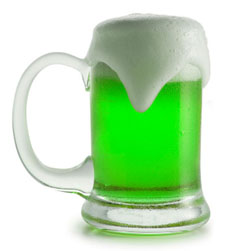|

[1] Some say there’s nothing better than hot jalapeño poppers with a cold beer (photos #1 and #2 © Anchor Foods).

[2] Poppers appreciate a creamy dip. Or, you can serve them with salsa.
|
|
Who knew that jalapeño poppers were invented by a major food company? We always figured they’d come out of some hip Tex-Mex restaurant.
But it turns out that Anchor Food Products of Appleton, Wisconsin invented jalapeño poppers in 1992—making 2012 the 20th anniversary of poppers.
The original poppers were jalapeño chiles stuffed with cream cheese or Cheddar, battered and deep-fried—a spicy American snack version of the Mexican dish, Chiles Rellenos (stuffed bell peppers). The company is a major supplier to restaurants, and that’s where most people head for poppers (here’s a restaurant locator), along with a “Like to Party” Facebook Sweepstakes).
You can also find Anchor Poppers in the frozen foods section of the supermarket. Anchor’s expanded line includes seven flavors, the most popular of which are Original, Cream Cheese & Cheddar Cheese Jalapeño Poppers and Fire-Roasted Poblano & Jalapeño Popper Bites.
Poppers are delicious with a beer and can be served with a dip or sauce: marinara sauce, pepper jelly, ranch dressing, salsa, or other favorite. We combine pepper jelly with fat-free Greek yogurt to add a bit of sweetness without the cholesterol; plus a breading of Japanese-style panko breadcrumbs.
Try some now, or save them for Cinco de Mayo.
MAKE YOUR OWN POPPERS
Baked Bacon-Wrapped Jalapeno Poppers With Pepper Jelly Filling
Baked Jalapeño Poppers With Cream Cheese & Breadcrumbs
Crunchy Cream Cheese-Stuffed Jalapeño Poppers
Jalapeno Poppers Stuffed With Mozzarella, Jack & Swiss
|
THE HISTORY OF JALAPEÑO POPPERS
While the actual date of the product launch is lost to time, Anchor Food Products applied for a trademark on the term “Jalapeño Poppers” on April 30, 1992.
Since the end of 2001, Anchor Poppers has been part of the H.J. Heinz family of brands; the poppers are produced by the McCain Foods division.
Find more about Anchor Poppers.
CHECK OUT WHAT’S HAPPENING ON OUR HOME PAGE, THENIBBLE.COM.
|







